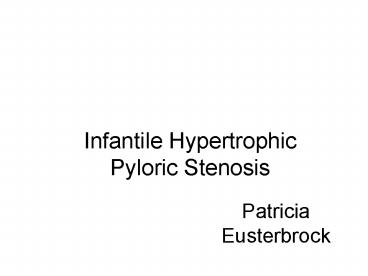Infantile Hypertrophic Pyloric Stenosis - PowerPoint PPT Presentation
1 / 11
Title:
Infantile Hypertrophic Pyloric Stenosis
Description:
Infantile Hypertrophic Pyloric Stenosis. Patricia Eusterbrock ... Decreased post-op emesis. Less post-op pain and analgesic use. Morbidity and Mortality ... – PowerPoint PPT presentation
Number of Views:579
Avg rating:3.0/5.0
Title: Infantile Hypertrophic Pyloric Stenosis
1
Infantile Hypertrophic Pyloric Stenosis
- Patricia Eusterbrock
2
Epidemiology
- 4 per 1,000 live births and increasing
- More common in Caucasians
- Malefemale 41 to 61
- Increased incidence in B and O blood types
- More common in first born
3
Etiology
- Abnormal muscle innervation
- Nitric oxide synthetase defect
- Neonatal hypergastrinemia
- Gastric hyperacidity
- Erythromycin
4
Presentation
- 3-6 wks of life
- Increase in frequency, volume and force of
nonbilious vomiting - Hungry vomiter
- Lethargy
- Weight loss
- Symptoms continue despite changes in formula
5
Objective Findings
- Physical exam
- Peristaltic waves
- RUQ mass
- Weight loss
- Labs
- Hypochloremia
- Hypokalemia
- Metabolic alkalosis
6
Imaging
- Ultrasound
- Criteria for diagnosis
- Pyloric muscle thickness gt 4 mm
- Diameter gt 14 mm
- Channel length gt 16 mm
- Upper GI series
- Shoulder sign
- Double track or string sign
- Upper endoscopy
7
String Sign
8
Treatment
- Conservative management with atropine
- Surgical intervention Ramstedt pyloromyotomy
- Pre-op correction of volume depletion and
electrolyte imbalance
9
Operative Technique
- Open approach
- Transverse RUQ incision
- Supraumbilical curvilinear incision with midline
fascial opening - Laparoscopic
- Decreased post-op emesis
- Less post-op pain and analgesic use
10
Morbidity and Mortality
- Morbidity 1-5
- Complications
- Incomplete myotomy
- Wound dehiscence
- Recurrence 1-3
- Mortality lt0.5
11
Take Home Points
- Typically presents within first 6 wks of life
with progressive vomiting, palpable RUQ mass, wt
loss, and electrolyte abnormalities. - Ultrasound is preferred for visualization of
hypertrophied pylorus. - Surgical intervention is standard of care after
volume depletion and electrolytes have been
corrected. - Feedings should be restarted 6-12 hrs post-op.































